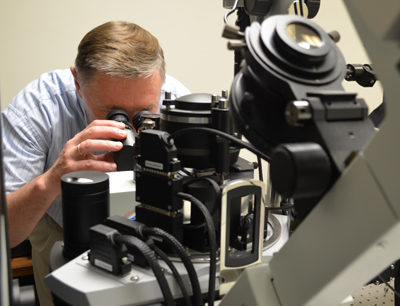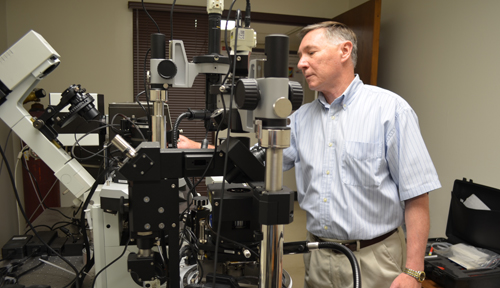First, Yuri Lyubchenko, Ph.D., professor of pharmaceutical science in the College of Pharmacy, has a question: Are you familiar with the concept of a record player?
When the answer is “Yes,” Dr. Lyubchenko is relieved. So many students these days know only iPods, MP3s and streaming. They’ve never put a needle on vinyl.
But that — a record-player needle — is the principle behind the atomic force microscope (AFM).
In much the way a phonograph needle can decipher music in a record’s grooves, the AFM needle is sensitive enough to show very tiny details (nanometer scale) at incredibly high speeds.
Among nine various AFM instruments, UNMC houses a unique atomic force microscope, high-speed AFM. This instrument is capable of the time-lapse nanoscale imaging with video rate.
 |
Until UC Berkley recently acquired a similar instrument, UNMC’s was the only one of its kind in the U.S.
Yet it’s kept without fanfare at the College of Pharmacy, behind an ordinary (locked) door, housed in a closet-sized room. Chances are you haven’t even heard it’s on campus.
But it allows Dr. Lyubchenko’s lab and others to do the kind of work that moves the needle — so to speak.
It holds a unique capability to manipulate single molecules and measure their interaction.
This property was especially important when looking into neurodegenerative disorders like Alzheimer’s, Huntington’s and Parkinson’s diseases.
Those diseases are caused by the misfolding and aggregation of proteins. When misfolded states are probed with AFM-force spectroscopy, UNMC scientists are able to identify them and characterize their properties. Researchers are then able to see why this misfolding and aggregation is so devastating.
See DNA unraveling, captured by the atomic force microscope.
“The major finding,” said Dr. Lyubchenko, “is that a misfolding dimer has an extremely long lifetime.”
A dimer is comprised of two bonded, structurally similar monomers, the building blocks of complex molecules.
“The high stability of misfolded dimers is a fundamental finding, suggesting that the formation of dimers leads to enormous stabilization of the protein misfolded state.”
Likewise, scientists know that the protein APOBEC3G can block HIV replication. But there are still many details to discover, in order to definitively determine the process. With the high-speed AFM technology, Dr. Lyubchenko and his team study the nanoscale structure and dynamics of APOBEC3G complexes with the DNA target.
They can actually image what happens.
UNMC scientists also are looking for ways to take advantage of AFM technologies in molecular pharmacology, drug design and other biomedical areas.

It would be great if you could post an image.
An avi file has been added. Thank you for the suggestion.